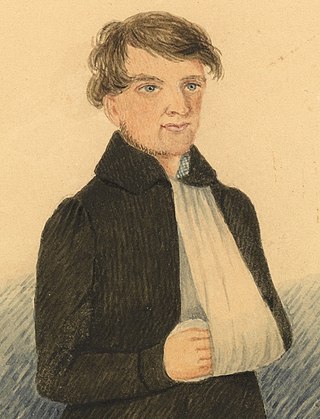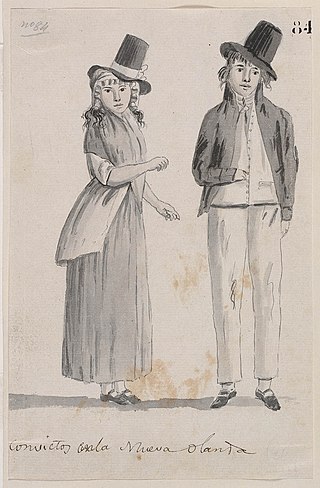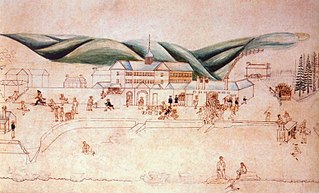Related Research Articles

The history of Norfolk Island dates back to the fourteenth or fifteenth century when it was settled by Polynesian seafarers.

The Macquarie Harbour Penal Station, a former British colonial penal settlement, established on Sarah Island, Macquarie Harbour, in the former colony of Van Diemen's Land, now Tasmania, operated between 1822 and 1833. The settlement housed male convicts, with a small number of women housed on a nearby island. During its 11 years of operation, the penal colony achieved a reputation as one of the harshest penal settlements in the Australian colonies. The former penal station is located on the eight-hectare (twenty-acre) Sarah Island that now operates as a historic site under the direction of the Tasmania Parks and Wildlife Service.
Alexander Maconochie was a Scottish naval officer, geographer and penal reformer.

John Piper was a military officer, public servant and landowner in the colony of New South Wales. The Sydney suburb of Point Piper was named in his honour.

John Giles Price, was a colonial administrator in Australia. He served as the Civil Commandant of the convict settlement at Norfolk Island from August 1846 to January 1853, and later as Inspector-General of penal establishments in Victoria, during which he was "stoned to death" by angry and disgruntled prisoners.

Lieutenant Colonel James Thomas Morisset, penal administrator, was commandant of the second convict settlement at Norfolk Island, from 29 June 1829 to 1834.
Major Richard Turton was an officer of the 40th Regiment stationed at Sydney. He was selected to lead the first party of convicts in the re-establishment of the second convict settlement at Norfolk Island. The island had been abandoned since the first convict settlement was finally removed in 1814. The new settlement was intended to be the most severe settlement, where the worst convicts would be sent, without hope of escape and offering, in Governor Darling's view, "the extremest punishment short of death". With 34 soldiers, 57 convicts, and 12 soldiers' wives and children, he landed on 6 June 1825. Most of the convicts were tradesmen to clear the regrowth and prepare buildings. A treadmill was planned, but never sent.
Colonel Thomas Edward Wright, soldier and penal administrator, of the 39th Regiment was the third commandant of the second convict settlement at Norfolk Island, from August 1827 to 1828.
Captain Joseph Wakefield, soldier and penal administrator, of the 39th Regiment was the acting commandant of the second convict settlement at Norfolk Island, from November 1828 to 29 June 1829.

Lieutenant-Colonel Joseph Anderson, soldier and penal administrator, of the 50th Regiment, was commandant of the second convict settlement at Norfolk Island, from March 1834 to February 1839. Anderson was also a politician, a member of the Victorian Legislative Council from 1852 to 1856.
Major Joseph Childs (1787–1870) was a British Royal Marines officer and penal administrator; he was commandant of the second convict settlement at Norfolk Island, from 7 February 1844 to August 1846.
Captain Rupert Deering, soldier and penal administrator of the 99th Regiment, was Commandant of the second convict settlement at Norfolk Island. His tenure lasted from the departure of John Price in January 1853 to September of the same year.

Foster Fyans was an Irish military officer, penal colony administrator and public servant. He was acting commandant of the second convict settlement at Norfolk Island, the commandant of the Moreton Bay penal settlement at Brisbane, the first police magistrate at Geelong, and commissioner of crown lands for the Portland Bay pastoral district in the Port Phillip District of New South Wales. He is the great-great-grandfather of actor Sam Neill.

Lawrence Kavenagh was an Irish-Australian convict bushranger who, with Martin Cash and George Jones, escaped from Port Arthur, Van Diemen's Land, in late 1842. The three men took to bushranging for a six-month period, robbing homesteads and inns with seeming impunity. Kavenagh was tried for serious crimes on five separate occasions. He was executed in 1846 at Norfolk Island.

Between 1788 and 1868 the British penal system transported about 162,000 convicts from Great Britain and Ireland to various penal colonies in Australia.
Charles Fraser or Frazer or Frazier was Colonial Botanist of New South Wales from 1821 to 1831. He collected and catalogued numerous Australian plant species, and participated in a number of exploring expeditions. He was a member of the Stirling expedition of 1827, and his report on the quality of the soil was instrumental in the decision to establish the Swan River Colony.

Kingston and Arthurs Vale Historic Area (KAVHA) is an old settlement on the Kingston coastal plains, southern side of Norfolk Island, consisting of a large group of buildings from the British Empire's convict era (1788–1855), now considered to be of such cultural significance to Australia and to the World that the area has been formally inscribed onto both the Australian National Heritage List and UNESCO's World Heritage list as amongst:
" .. the best surviving examples of large-scale convict transportation and the colonial expansion of European powers through the presence and labour of convicts."
Norfolk Island convict mutinies were a series of armed uprisings by convicts on the penal colony of Norfolk Island, Australia. All were unsuccessful.

The Cooking Pot Uprising or Cooking Pot Riot was an uprising of convicts led by William Westwood in the penal colony of Norfolk Island, Australia. It occurred on 1 July 1846 in response to the confiscation of convicts' cooking vessels under the orders of the Commandant of the penal settlement, Major Joseph Childs.

From the late 1700s until the end of the 19th century, the British Empire established, expanded and maintained a number of colonies on the continent of Australia. These colonies included New South Wales, Van Diemen's Land, Western Australia, South Australia, Victoria and Queensland. Many of these were initially formed as penal settlements, and all were built on land occupied by Indigenous Australians. In order to keep the large number of transported convicts under control, enforce colonial law and fight the Australian frontier wars, British military elements, including the British Army, were deployed and garrisoned in Australia. From 1790 to 1870 over 30 different regiments of the British Army consisting of a combined total of around 20,000 soldiers were based in the Australian British colonies.
References
- Hazzard, Margaret, Punishment Short of Death: a history of the penal settlement at Norfolk Island, Melbourne, Hyland, 1984. ( ISBN 0-908090-64-1)